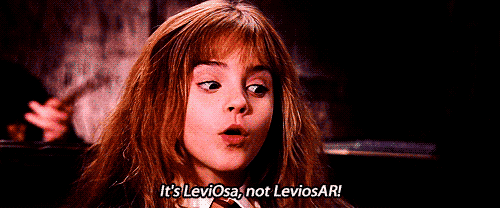Bechdel Testing the Final Showdown
For those of you unfamiliar with the Bechdel test, it is a way to judge films by the presence and depth of female characters within storylines. The Harry Potter series, being not only written by a woman but also promoting strong female characters, would appear obvious in passing the Bechdel test. In reality, however, our beloved movie adaptations do not quite fit the requirements compared to what the books offer us. For this post, I will focus on the final movie, Harry Potter and the Deathly Hallows – Part 2, and may in the future explore the movies in descending order with input from fans! So please comment and voice your opinions at the end of this post! All right, let’s do it!

You have got to love yourself some Hermione! Source
The film Harry Potter and the Deathly Hallows – Part 2 just barely passes the Bechdel test in two different scenes. The first scene that passes is only around seven seconds long. Minerva McGonagall, a professor of Transfiguration, magicks the statues of the castle with the spell “Piertotum Locomotor” in order to help create an extra defense buffer for the impending Death Eater army. She initially talks to Filius Flitwick, a male part-goblin who is a professor of Charms, but once he leaves the scene she turns to Molly Weasley, who has been standing beside her throughout this scene, watching the defensive enchantments go up into place around Hogwarts. McGonagall then says, “I’ve always wanted to use that spell!” Though Molly never responds with words, she casts a look at McGonagall in acknowledgment of what she said and the impending danger.
The second passing scene is toward the end of the movie and is about 30 seconds long. It features Molly Weasley once again. It begins when Bellatrix Lestrange, a female Death Eater, casts a Killing Curse toward Ginny Weasley, Molly’s daughter. Luckily, Ginny blocks the spell, but it unnerves Molly, who pushes Ginny behind her, points her wand at Bellatrix, and snarls, “Not my daughter, you bitch!” Bellatrix cackles and laughs, and the two women continue to battle and send hexes at each other for the duration of the scene.
These two scenes, though short, help the movie pass because neither scene has a focus on men as the primary scene characters or a conversation between women about men. The first one shows McGonagall all impressed and pleased with her chance to do a spell she thought she’d never get to do (though still morbid and sad, in a sense), and the second scene highlights the protective nature of Molly, and the two women fight over the fact that Bellatrix tried to kill Molly’s daughter Ginny, also a woman. The only disappointing part about Harry Potter and the Deathly Hallows – Part 2 passing the Bechdel test is that it passes just barely with short scenes for these incredible women (and yes, that includes Bellatrix, despite which side she is on).
I love this movie and the others in the series deeply, but I also believe there is still room to explore how the Bechdel test affects the other Harry Potter films. It is a fair way to test the female presence in movies and if they are being represented authentically. In Harry Potter they are represented authentically but not always in equal screen time to the boys; however, I acknowledge that the series focuses mostly on Harry and not the other side plots that the book has. Many of the side plots would have helped the movies pass should those scenes be included in the films.
What do you think? Are there any other moments in Deathly Hallows – Part 2 that I missed that help the film further pass the Bechdel test? Any other thoughts of female representation in both the final showdown and previous films?




